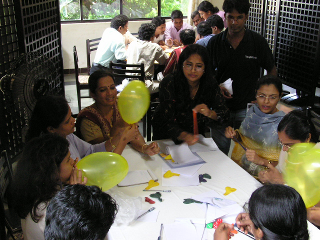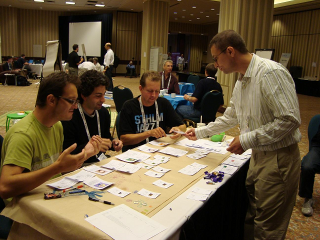Yesterday we learnt about the Agile Values. Today we’re putting the Agile Values into practice. Let’s see what happens when we put our personal Agility to the test.
There are many counter-intuitive ideas in Agile, so it’s only natural that people resist them. The best and safest way to show they work is by trying them out in a simulation of a project.
We play two games where the team can experiment with new ideas before deciding whether or not they’ll work in the real world. The goal of the Agile Games Day is to establish a common understanding of Agile and how it applies to this team.
Today’s schedule looks like this:
| Duration | Activity |
|---|---|
| 10 min | Define our Agile learning acceptance criteria |
| 150-180 min | The XP Game |
| Lunch |
|
| 90-100 min | The Business Value Game |
| 90-100 min | How we’re going to use Agile on this project |
| 10-15 min | Personal Agility Re-Ratings Exercise |
| 10-15 min | Agile Games Day retrospective and review our learning acceptance criteria |
We start by clarifying what participants want to learn from the day in the form of acceptance criteria. Then we play the XP Game, a simulation of three releases by an Agile team. The game allows us to experiment with team roles and responsibilities, Agile planning and estimation, customer collaboration, user stories and acceptance criteria. After much fun and games, we apply the principle of sustainable pace and take an hour for lunch.
After lunch we address the age-old problem: Where do stories come from? And more importantly, what is “Business Value” and how do we estimate it? The Business Value Game is a simulation of six releases. The game allows us to experiment with various planning and prioritising strategies, the use of a Business Value Model and the role of the internal customer.
Next we put what we learnt into practice by:
- Reiterating the goal of the project to really understand what our organisation values most
- Identifying the Agile practices we’ll adopt first
- Customising the practices to suit our team and the context in which we work
- Discussing the team roles and responsibilities and signing up to them
- Committing to do our best as an Agile team.
We end the day with two more exercises. We revisit the Personal Agility Rating exercise and re-rate ourselves based on what we’ve learned. And finally, we demonstrate the principle of Continuous Improvement by doing a retrospective on the Agile Games Day. It’s also an opportunity for us to verify if each of us have met our learning acceptance criteria.
Portia says: In our experience, the way people play foretells how the team’s first couple of iterations will turn out.
Pascal says: When we do a re-rating exercise, the ratings of a learning individual usually go down because they realise how hard it is to put the Agile Values into practice, especially under pressure.
Why does this work?
The Agile Games Day has consistently proven to be the most effective way of giving your team their first Aha! moment.
- It demonstrates the importance of learning and Continuous Improvement
- Experiential learning makes people think both during the game and a long time after
- The Aha! moment triggers the start of a fundamental mindset shift
- The games provide an accelerated experience of the Tuckman Model in action: forming, storming, norming, performing
- The combination of activities throughout the day address the four modes of learning:
- Somatic: learning by moving and doing
- Auditory: learning by talking and hearing
- Visual: learning by observing and picturing
- Intellectual: learning by problem solving and reflecting




